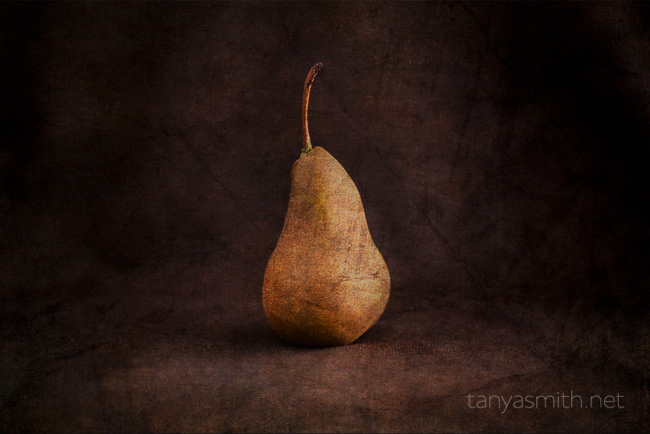
Some photographers might shun the whole texture overlay thing, but I have a lot of fun experimenting with them. SLR Lounge has recently released a really useful set of handmade textures that can be used royalty free by photographers and I was really excited to try them out.
I consider myself to be pretty Photoshop savvy, especially when it comes to blend modes and adding textures, so I wasn’t really sure if I would need to watch the available tutorial. I decided to give it a whirl, though and I highly recommend it, even for seasoned pros. I picked up several new tips and tricks from Pye in the videos.
Now, here’s a little peek at just a few of the 200+ handmade paper textures available in the set and how you might use them.
I started with a photo of a pear I took earlier this year. I shot this with a Canon 5D Mark III and Canon 85mm f/1.8 lens using window light at camera right and a white reflector at camera left. I have bumped up the contrast and exposure slightly in Lightroom and then opened it up in Adobe Photoshop.
Next I opened up one of the blended texture files from the SLR Lounge Photoshop Paper Texture Collection and added it to my original file on a separate layer. By the way, in Pye’s video tutorial that comes with the textures, he teaches a shortcut for opening multiple files into one layered file, which is a major time saver!
Then I changed the blend mode to multiply. This is probably the blend mode I most often use.
I wanted to add some warmth and dimension to the pear, so I went in search of another file within the set.
I added it to my file in a separate layer and changed the blend mode to color dodge, which brightens up the pear considerably.
I felt the background, especially around the edges, needed to be darkened up a bit more. Rather than add a standard vignette, I found a texture that was darker around the edge and added it to my file.
I set the blend mode on this texture to multiply, which darkens up that background beautifully, but now the pear is too dark…
So, I added a layer mask and set a feathered paint brush to about 30% opacity and 30% flow and lightly painted away some of the darkness on the pear. I also lightened up the highlights on the background and the area in front of the pear to give it dimension.
In the textures video tutorials, Pye recommends you actually use frequency separation (and shows you how to do it) for knocking back texture in areas where you don’t want it, so you won’t have to deal with any color shifting in your image. In this case I did want to lighten up the color and remove texture in those areas of my photo, so I went ahead and used a layer mask.
Next, I actually decided the texture on the bottom left of the image was a little distracting, so I did some experimenting and found that if I rotated the texture it solved the problem. Easy, peasy. Alternately, I could have chosen a different texture or removed some of the texture in that area using the previously mentioned frequency separation method.
Lastly, I cropped the image slightly to center everything up and I’m done.
Here’s the final image. I love the painterly, fine art look of this still life. Obviously this is a pretty extreme use of textures, but they can be utilized in a more subtle way to add character to your work. The possibilities are pretty endless with this great set the SLR Lounge team has created. I can’t believe they are only $39, too. So cheap for what you’re getting. Click here to check it out.
Anyway, stay tuned for my post this weekend showcasing some DIY gift and home decor ideas utilizing images from this series. They will be Pinterest worthy if it kills me.
[Rewind: Build Your Own ‘Still Life’ Folding Table for around $30]
How have you used textures in your work (or are you one of those purist photogs who swears you’ll never try them)? Please share your opinion…
CREDITS: All photographs by Tanya Smith are copyrighted and have been used with permission for SLR Lounge. Do not copy, modify or re-post this article or images without express permission from SLR Lounge and the artist.
More Info
If you’ve enjoyed this tutorial, be sure to check out our Photoshop Paper Textures in our Store! See the trailer below.
















Get Connected!